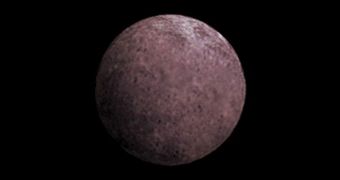Recent studies conducted on the small object called Snow White revealed that the small world may still retain some faint traces of a former atmosphere. Some astronomers classify this world as a dwarf planet, although the debate as to what exactly this object is is still ongoing.
Past investigations conducted on the small world led astronomers to discover a layer of snow covering the diminutive space rock. Add in the new discovery, and you get the image of a world that was active for at least a short period of its long life.
The official name for snow white is 2007 OR10. It is located in the Kuiper Belt, a ring of space rocks that lies behind the orbit of Neptune. More renowned inhabitants of the Belt include the dwarf planets Pluto, Eris, Haumea and Makemake.
Only half of the small planetoid is covered by ice, experts say, while the other half is reddish in appearance. According to planetary scientists, the white comes from snow that was released to the surface from ancient cryovolcanoes.
The reddish color is most likely caused by elevated methane concentrations on that part of the object. The hydrocarbon must be what remains of an atmosphere that used to surround Snow White long ago.
“You get to see this nice picture of what once was an active little world with water volcanoes and an atmosphere, and it's now just frozen, dead, with an atmosphere that's slowly slipping away,” explains California Institute of Technology (Caltech) expert and lead study author Mike Brown.
When 2007 OR10 was first discovered, astronomers proposed that it represented a shard of Haumea, a Kuiper Belt Object (KBO) that looks extremely weird itself. Astronomers say that the space rock – which closely resembles a football – is also covered in a sheet of water ice.
In order to conduct the recent investigation, the researchers used the 6.5-meter Magellan Baade Telescope, which is located in Chile. They were not expecting Snow White to contain too much water ice, but were surprised when they found out that half of the object was covered in the stuff.
“That was a big shock. Water ice is not red,” Brown explains, quoted by Space. Details of the new investigation were published in last month's issue of the Astrophysical Journal Letters.
“That combination – red and water – says to me 'methane.' We're basically looking at the last gasp of Snow White. For four and a half billion years, Snow White has been sitting out there, slowly losing its atmosphere, and now there's just a little bit left,” the expert adds.
However, the researcher and his team admit that the evidences for the presence of methane are not conclusive. They say that additional researches need to be conducted before a clear conclusion can be derived from this study.

 14 DAY TRIAL //
14 DAY TRIAL //